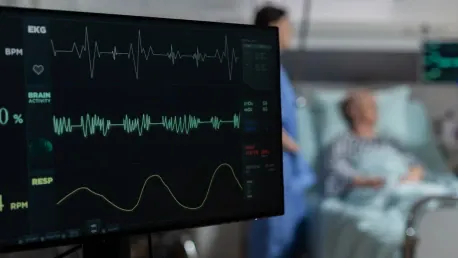The handheld multi-parameter monitoring devices market is witnessing phenomenal growth, driven by an escalating demand for portable, real-time health monitoring solutions. From an anticipated valuation of USD 3.2 billion in 2024, the market is projected to soar to USD 5.3 billion by 2035, marking a compound annual growth rate (CAGR) of 4.6%. This dynamic expansion is powered by technological advancements, an increasing prevalence of chronic diseases, a transition towards remote patient monitoring, and an aging population that underscores the need for practical and accessible healthcare solutions.
Key Trends in the Market
Increasing Prevalence of Chronic Diseases
The rise in chronic diseases such as cardiovascular disorders, diabetes, and respiratory illnesses significantly propels the demand for handheld health monitoring devices. As these conditions often require continuous monitoring to manage effectively, the availability of portable, user-friendly devices becomes essential. Continuous glucose monitors for diabetic patients or portable EKG machines for cardiac patients highlight the importance of having reliable health management tools accessible at all times. This pattern is evident across the globe, further accelerating market growth and adoption.
Home healthcare and remote patient monitoring have increasingly become the norm, providing indispensable support to patients managing chronic conditions. These devices minimize the necessity for frequent hospital visits, offering convenience and flexibility for both patients and healthcare providers. The shift towards personalized and decentralized healthcare solutions underscores the significance of these developments. With the focus always on patient comfort and precision, the evolution of wearable health technology plays an essential role in this transition and fuels the broader acceptance of these innovative devices.
Advances in Sensor and Wearable Technologies
Innovations in sensor and wearable technologies have introduced lightweight, non-invasive, and AI-integrated monitoring systems, thus significantly enhancing their usability and accuracy. These advancements enable devices to collect comprehensive health data efficiently, providing detailed insights into a user’s condition. Wearables with AI capabilities can predict potential health risks by analyzing patterns in the collected data, offering a proactive approach to health management. The seamless integration of these devices into daily life makes them a pivotal tool in modern healthcare strategies.
The enhanced usability of these advanced monitoring devices ensures they can be operated effortlessly by individuals with varying levels of technological proficiency. This accessibility is crucial in ensuring broad adoption, particularly among the older population, who may initially be more hesitant to use complex healthcare gadgets. As technology continues to advance, the ergonomic design and user-centric features of these devices will only improve, aligning with the growing emphasis on patient-friendly healthcare solutions. The focus on comfort and ease-of-use fundamentally drives the market forward.
Integration of Telemedicine and Digital Health
Adoption of Cloud-Based and Bluetooth-Enabled Diagnostic Tools
The adoption of telemedicine and digital health is fostering significant growth in the handheld health monitoring devices market. Cloud-based and Bluetooth-enabled diagnostic tools have revolutionized real-time and remote health diagnostics, making data collection and analysis more efficient than ever before. These technologies allow for seamless data transfer, enabling healthcare professionals to monitor patient health remotely and provide timely interventions. This trend aligns with the broader consensus that future healthcare delivery will increasingly depend on real-time and remote diagnostics.
These advanced diagnostic tools also ensure enhanced patient engagement by offering them direct access to their health data. Patients are equipped to manage their conditions more effectively, as they can monitor their vital signs consistently. Additionally, the integration of telemedicine platforms with these devices supports efficient virtual consultations, ensuring uninterrupted medical care irrespective of geographical barriers. This consolidation of technology in healthcare underlines a significant shift towards more dynamic and accessible medical practices.
Leading Companies and Innovative Solutions
Dominant companies such as Medtronic, Philips Healthcare, GE Healthcare, Masimo Corporation, and Omron Healthcare play a pivotal role in this market, providing advanced portable health monitoring solutions. For instance, Medtronic is renowned for its wearable and wireless patient monitoring solutions that have set new standards in healthcare. Philips Healthcare excels in offering multi-parameter diagnostic devices that capture comprehensive health data, essential for accurate diagnosis and treatment. GE Healthcare’s portable vital signs monitors and telehealth solutions have significantly contributed to the expansion of remote patient care.
Furthermore, Masimo Corporation specializes in innovative pulse oximetry and remote monitoring technologies, while Omron Healthcare stands out for its reliable blood pressure monitors and home health solutions. These industry leaders are continuously pushing the boundaries of innovation to address evolving healthcare demands. By providing cutting-edge solutions, they contribute to the market’s growth and ensure that both patients and healthcare providers have access to the best tools available for effective health management.
Future Considerations for the Market
Growth Potential and Technological Innovations
The future of the handheld multi-parameter monitoring devices market looks promising, with significant growth potential driven by technological innovations and evolving healthcare needs. The integration of cloud-based analytics and advanced sensor technologies will likely revolutionize point-of-care diagnostics, enabling more precise and real-time health monitoring. These advancements promise to enhance healthcare delivery, making it more efficient and responsive to individual patient needs. As awareness regarding health management increases, the demand for such devices will only continue to rise.
Influence of Key Industry Players
The market for handheld multi-parameter monitoring devices is experiencing remarkable growth due to the increasing demand for portable, real-time health monitoring solutions. Projected to grow from an estimated valuation of USD 3.2 billion in 2024 to USD 5.3 billion by 2035, the market is anticipated to achieve a compound annual growth rate (CAGR) of 4.6%. This significant expansion is fueled by several factors, including technological advancements, a rising prevalence of chronic diseases, and a shift towards remote patient monitoring. Furthermore, an aging population exacerbates the urgent need for practical, accessible healthcare solutions. As healthcare systems worldwide strive to improve efficiency and patient outcomes, the adoption of these versatile, user-friendly monitoring devices is expected to surge. The ability to monitor various health parameters in real-time without the need for traditional hospital visits is revolutionizing patient care, making these devices indispensable tools in modern healthcare management.









